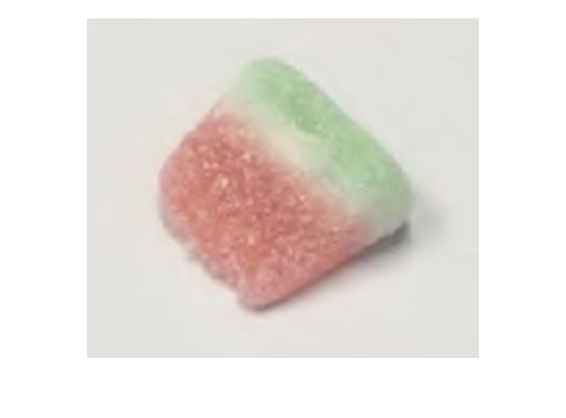“Rather than divide and conquer, when features’ designs together serve a function, we look at those designs together.” – Third Circuit

Source: Third Circuit opinion
On September 7, the U.S. Court of Appeals for the Third Circuit issued a precedential decision on trademark functionality doctrine in PIM Brands Inc. v. Haribo of America Inc. In affirming the district court’s grant of summary judgment, the Third Circuit found that PIM’s federally registered trademark to a wedge-shaped candy with green, white and red stripes should be canceled because the mark as a whole identifies the candy’s flavor.
PIM Appeals District Court Decision to Consider Color and Shape Together
After introducing its Sour Jacks Wedges gummy candies in the early 2000s, PIM Brands obtained federal trademark registrations covering its confections: one protecting a wedge candy with speckled green, white and red sections; and a supplemental trademark registration for a tricolored wedge candy with unspecified colors. PIM added the color description to its federally registered mark after examiners at the U.S. Patent and Trademark Office (USPTO) rejected PIM’s initial application, which only claimed the candy’s wedge shape.
PIM Brands filed suit against rival gummy maker Haribo in the District of New Jersey in June 2019 following Haribo’s introduction of a watermelon chewy candy with a similar shape and coloring to PIM’s candy. PIM’s suit included claims under the Lanham Act for trademark and trade dress infringement, as well as claims under New Jersey’s unfair competition law. Although PIM’s federal trademark registration gave the mark presumptive validity under 15 U.S.C. 1057(b), the district court ruled on summary judgment that Haribo had carried its burden of showing that no genuine dispute of material fact existed regarding the functionality of PIM’s claimed mark.
On appeal to the Third Circuit, PIM acknowledged that the coloring of its watermelon candy was functional as it identified the candy’s flavor. However, it asserted that the candy’s wedge shape separately identified the brand and challenged the district court’s decision to consider the wedge shape and coloring together when assessing functionality.
Ezaki Glico Does Not Require ‘Divide and Conquer’ Functionality Analysis
At the outset of its legal analysis, the appellate court explained that designs exhibiting any usefulness aside from branding are functional and cannot be protected as trademarks. “Even if the design chosen both promotes a brand and also ‘makes a product work better,’ it is functional and unprotectable,” the Third Circuit wrote, citing language from its 2021 functionality ruling in Ezaki Glico v. Lotte International America.
PIM had argued that, under Ezaki Glico, the Third Circuit was required to analyze trade dress features independently to determine whether those features were functional. “[T]hat claim overreads Ezaki Glico,” the Third Circuit found. In that case, the appellate court separated aspects of Ezaki Glico’s combined trade dress, a stick-shaped cookie partially dipped in chocolate, because those aspects contributed to separate functions: the cookie’s stick shape enabled better packaging, and the partial chocolate covering gave consumers a clean handhold for the cookie.
By contrast, PIM’s asserted trade dress involves aspects that can be separated but ultimately serve the same flavor identifying function, the Third Circuit ruled. “Rather than divide and conquer, when features’ designs together serve a function, we look at those designs together,” the appellate court explained. Analyzing the Lanham Act’s proscription against functional marks codified at 15 U.S.C. § 1052(e)(5), the Third Circuit said that a product’s whole trade dress is functional if it serves a single function and each feature’s design contributes to that function.
“Because the functionality bar is low, all the design need do is give the product a significant competitive edge beyond identifying its source… And not all consumers have to see the trade dress as serving a function beyond identifying the product’s source. It is enough that all reasonable jurors would conclude that a significant number of consumers would see it that way.”
A side-by-side comparison of PIM’s candy with actual slices of watermelon was “worth a thousand words of briefing” according to the Third Circuit, noting that the shape, colors and even orientations of the two objects match.

Source: Third Circuit opinion
While PIM argued slight differences, including the candy’s lack of black seeds and thicker band of green, PIM essentially conceded in its oral argument on appeal that the candy need not perfectly copy watermelon, but just evoke it. While the use of a rope or ribbon shape would have detracted from the functional nature of the color scheme, the appellate court found that the candy’s wedge shape removed all ambiguity. The Third Circuit’s ruling only impacts PIM’s primary registration, leaving its supplemental registration for wedge-shaped candy “intact for another day.”

![[IPWatchdog Logo]](https://ipwatchdog.com/wp-content/themes/IPWatchdog%20-%202023/assets/images/temp/logo-small@2x.png)

![[Advertisement]](https://ipwatchdog.com/wp-content/uploads/2024/04/UnitedLex-May-2-2024-sidebar-700x500-1.jpg)
![[Advertisement]](https://ipwatchdog.com/wp-content/uploads/2024/04/Artificial-Intelligence-2024-REPLAY-sidebar-700x500-corrected.jpg)
![[Advertisement]](https://ipwatchdog.com/wp-content/uploads/2024/04/Patent-Litigation-Masters-2024-sidebar-700x500-1.jpg)

![[Advertisement]](https://ipwatchdog.com/wp-content/uploads/2021/12/WEBINAR-336-x-280-px.png)
![[Advertisement]](https://ipwatchdog.com/wp-content/uploads/2021/12/2021-Patent-Practice-on-Demand-recorded-Feb-2021-336-x-280.jpg)
![[Advertisement]](https://ipwatchdog.com/wp-content/uploads/2021/12/Ad-4-The-Invent-Patent-System™.png)






Join the Discussion
No comments yet.